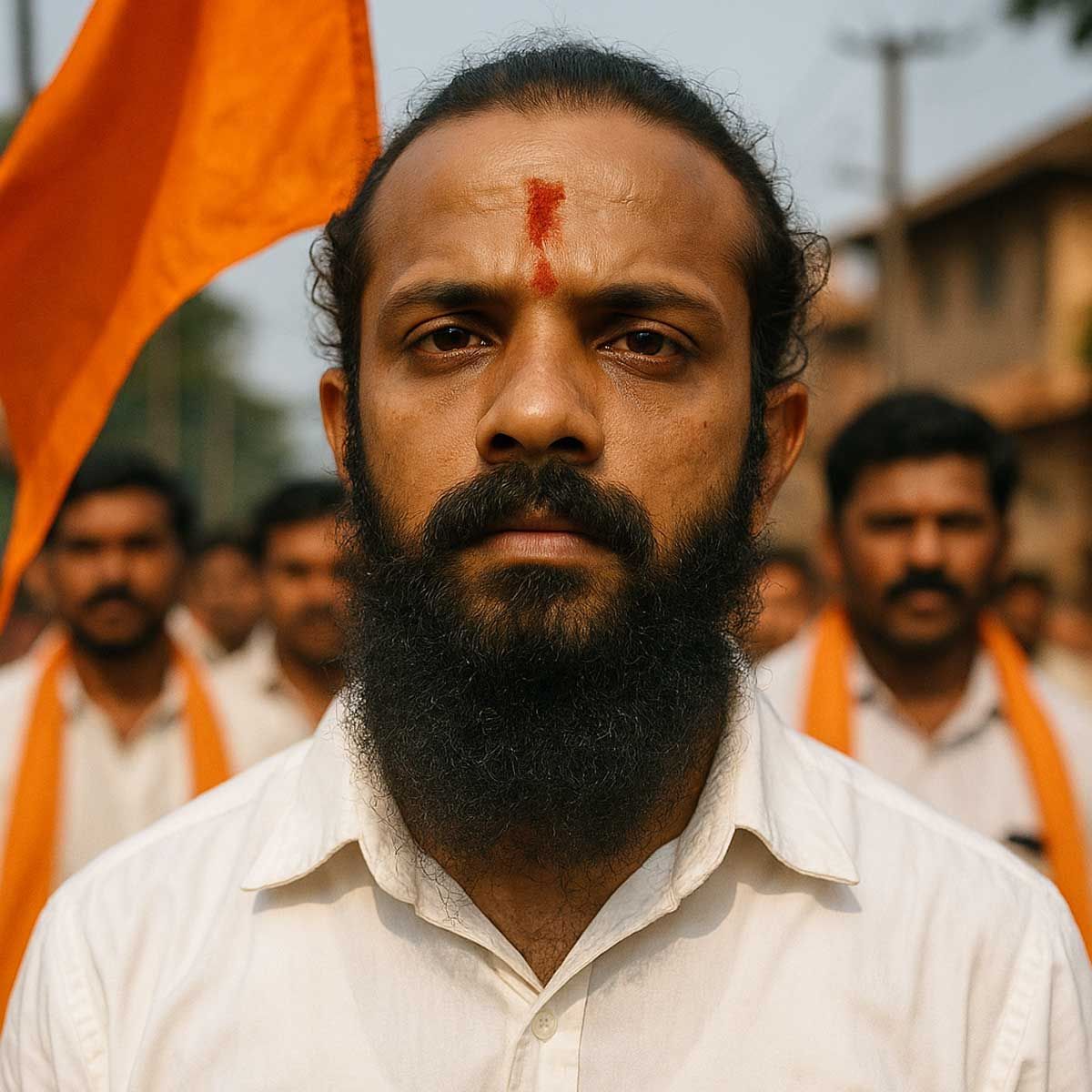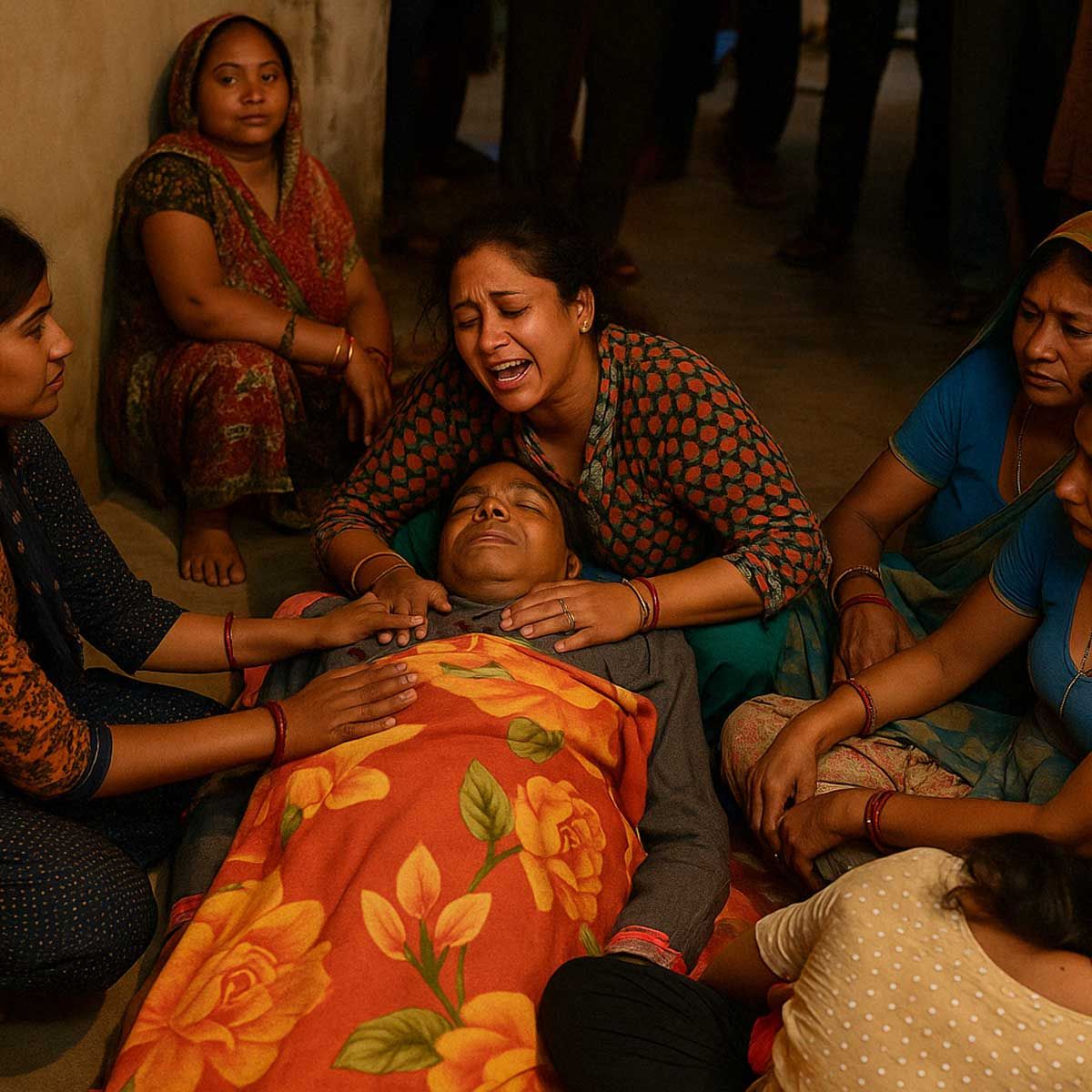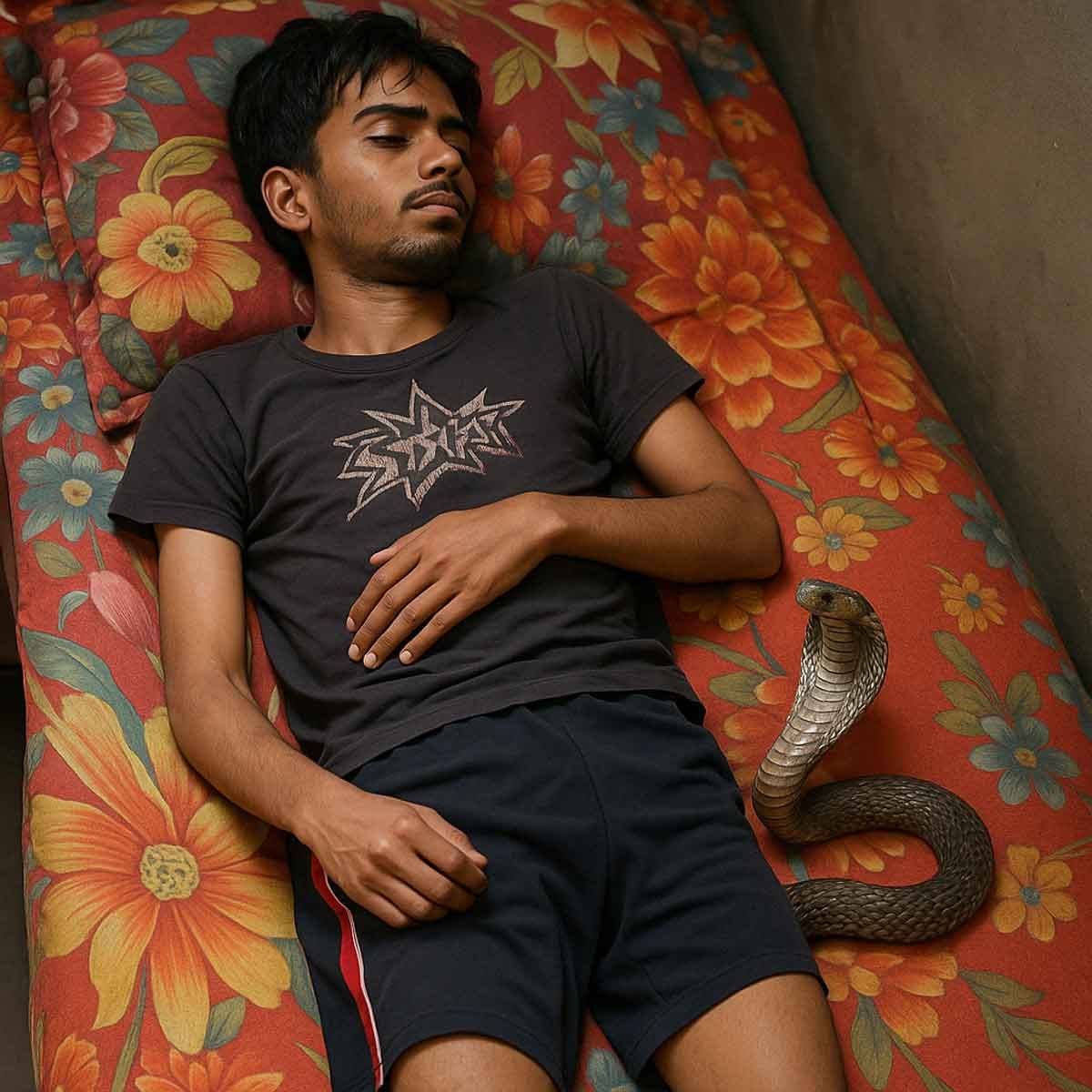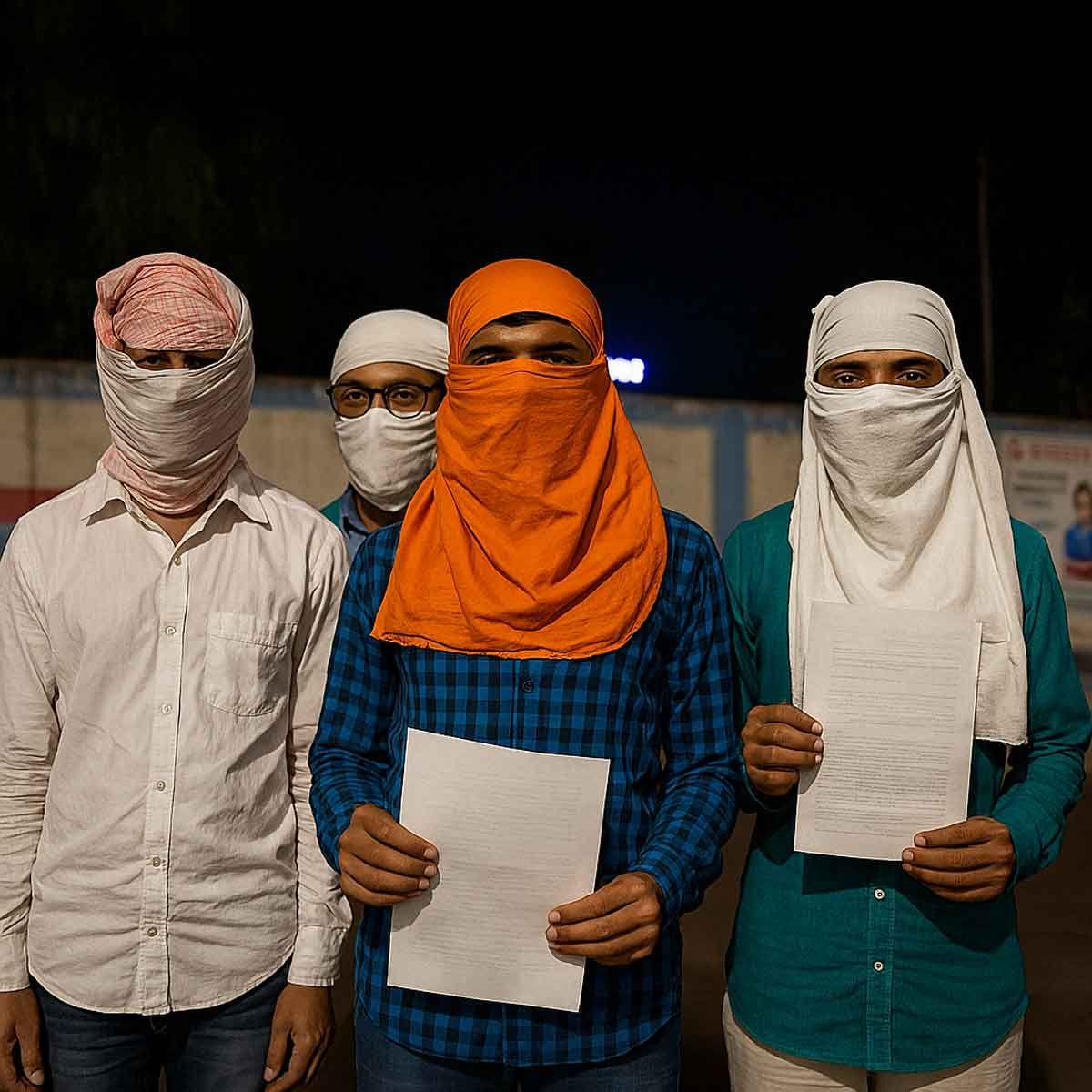More Coverage
Twitter Coverage
Satyaagrah
Written on
Satyaagrah
Written on
Satyaagrah
Written on
Satyaagrah
Written on
Satyaagrah
Written on
JOIN SATYAAGRAH SOCIAL MEDIA
"इतनी नफ़रत, क्यों?": Gujarat Congress leader arrested for defaming Ram Mandir's Mohit Pandey with manipulated images, Ahmedabad police act against Hiten Pithadiya, spotlighting the battle against digital misinformation and protecting religious dignity

In a recent development that has shocked many, the Ahmedabad Police have taken Gujarat Congress leader Hiten Pithadiya into custody. The arrest was made following his involvement in a deeply disturbing incident where he shared an obscene image, which was falsely presented as depicting the priest of the under-construction Ram Mandir in Ayodhya.
|
This incident involves a graphic photograph originally featuring a pornographic actor. However, in a deceitful and harmful act, the image was altered, commonly known as 'morphing', to make it appear as if the person in the picture was Mohit Pandey, the priest of the Ram Mandir. This act of digital manipulation aimed to falsely portray Pandey in an inappropriate and offensive light, causing harm to his reputation.
The gravity of this situation is underscored by the involvement of not just the local police but also authorities from another state. The Uttar Pradesh police have also stepped in, recognizing the severity of the issue. They have initiated legal proceedings against Pithadiya for his malicious actions targeting the Ram Mandir priest. The sharing of such morphed images not only disrespects an individual's dignity but also has the potential to stir unnecessary and harmful controversies, especially considering the religious and cultural significance of the Ram Mandir in
Ayodhya. This temple, a symbol of faith for many, is currently under construction and holds immense importance in the hearts of its devotees. The act of using such a revered figure in a scandalous and entirely fabricated context has understandably caused an uproar among the community.
This incident serves as a stark reminder of the dangerous power of misinformation and digital manipulation in the age of social media. The ease with which images can be altered and spread across platforms poses a significant challenge to the preservation of truth and personal dignity. In this case, the misuse of digital tools has led to a serious defamation of character, impacting not just the individual involved but also touching upon the sentiments of a larger community.
The arrest of Hiten Pithadiya by the Ahmedabad Police is a step towards addressing this malicious act. It highlights the law's commitment to protecting individuals against such baseless and harmful attacks on their character. This case is also a testament to the collaborative efforts of state police forces, with the Uttar Pradesh police's involvement underscoring the seriousness with which such offenses are treated across state lines.
As this story unfolds, it will be crucial to observe the legal proceedings and the broader implications for how society deals with the misuse of digital media to spread falsehoods and defame individuals. This incident is not just about the legal consequences for one individual but a broader conversation about ethics, responsibility, and respect in the digital age.
— The Hawk Eye (@thehawkeyex) December 12, 2023 |
On December 11th, a concerning incident unfolded on social media involving Hiten Pithadiya, a leader of the Congress party. Pithadiya shared several photographs that were not only inappropriate but also intentionally misleading. He claimed that these photographs depicted Mohit Pandey from Ghaziabad, who has recently been appointed as the priest for the Ram Lalla Temple in Ayodhya. This act by Pithadiya wasn't just an isolated incident; it represented a part of a larger, malicious campaign that has been targeting Pandey on social media since his appointment.
The photographs shared by Pithadiya showed a man in a compromising and objectionable position with a woman. These images were designed to scandalize and humiliate the individual they purported to represent. In his social media post on a platform referred to here as 'X', Pithadiya provocatively captioned the images with a question, "Is this the priest of Ayodhya Ram Temple?" This question, paired with the misleading images, was a clear attempt to cast doubt and aspersions on the character of Mohit Pandey, the newly appointed priest.
It’s important to note that the misleading actions of Pithadiya weren't solitary. Several other social media accounts, referred to as 'X handles', also participated in spreading these fake photographs. This coordinated effort to circulate the false images indicates a broader attempt to tarnish Pandey's reputation and, by extension, the sanctity of the Ram Lalla Temple, a place of significant religious importance.
Pithadiya holds a prominent position within the Congress party, serving as the head of the Scheduled Caste Morcha of the Gujarat Congress. The fact that someone in such a responsible and influential role chose to engage in spreading false and defamatory content raises serious concerns about the ethical standards and the use of social media by public figures. His actions not only brought disrepute to the individual in question but also to the political party he represents.
The implications of this incident are far-reaching. It underscores the ease with which misinformation can be spread in the digital age, especially when influential figures are involved. The incident is a stark reminder of the responsibility that comes with social media usage and the potential harm that can be caused when it is misused. It also highlights the need for vigilance among the public in questioning and verifying the authenticity of the information they encounter online, particularly when it concerns individuals' reputations or sensitive cultural and religious matters.
|
In a recent turn of events, a misinformation campaign was launched against Mohit Pandey, the appointed priest for the Ram Lalla Temple in Ayodhya. This campaign was based on a set of photographs shared on social media by Congress leader Hiten Pithadiya and others. The misleading factor in these photographs was the presence of tilak and sandalwood on the person's face. This detail was exploited to falsely claim that the person in the images was Pandey. In reality, the individual shown was not Pandey at all. The basis for this false connection was drawn from earlier, genuine pictures of Pandey where he was seen with tilak and sandalwood, traditional Hindu markings, which are common in religious contexts.
The spread of these fake images and claims led to significant controversy. Members of the Hindu community on social media were quick to recognize the falsehoods being propagated. In response, they began sharing screenshots of the objectionable tweets, calling attention to the disinformation campaign against Pandey. They strongly urged the police in both Ayodhya and Ahmedabad to take firm action against those responsible for disseminating these false claims. This collective response from the community was a clear stand against the misuse of social media to spread harmful and untrue statements.
It became increasingly clear that the motivation behind Pithadiya's actions was his bias against the Ram Temple and its newly appointed priest, Mohit Pandey. This bias was evident in the way the photographs were shared and presented. However, following the significant backlash from the public and the realization of the gravity of his actions, Pithadiya removed the tweets from his social media account. Unfortunately, the removal of these tweets did little to reverse the damage already caused by the spread of the misinformation.
Recognizing the seriousness of the situation, law enforcement agencies stepped in. Both the Ayodhya Police and the Ahmedabad Police initiated legal actions against Pithadiya. This move by the police was a significant step in addressing the spread of false information and holding those accountable who use their social media platforms to propagate harmful and baseless claims.
|
Journalist Janak Dave recently reported on a significant development in the case involving the spread of manipulated images by Congress leader Hiten Pithadiya. In a post on a social media platform referred to as 'X', Dave disclosed that the Ahmedabad Cyber Cell had arrested Pithadiya. The charges against him are serious and are framed under Sections 469, 509, 295A of the Indian Penal Code (IPC), along with relevant sections of the Information Technology (IT) Act. These sections deal with forgery, the intent to insult the modesty of a woman, and deliberate acts intended to outrage religious feelings, respectively.
The Cyber Crime Branch of the Ahmedabad police played a crucial role in this case. They apprehended Pithadiya on grounds of disseminating deepfake images that portrayed the Ayodhya priest in a compromised position with a woman. These images were shared across various social media platforms, leading to widespread misinformation and public outrage.
In an effort to confirm these developments, Deputy Commissioner of Police, Cyber Crime, Ajit Rajian, spoke to the Deccan Herald. He confirmed that Hitendra Pithadiya had indeed been arrested on the aforementioned charges. The specific mention of 'deepfake images' highlights the severity of the offense, as deepfake technology involves creating highly convincing but entirely false visual content. The charges brought against Pithadiya include Section 469 of the IPC, which deals with forgery for the purpose of harming someone’s reputation, and Section 509, which pertains to actions intended to insult the modesty of a woman. Additionally, Section 295 A addresses deliberate and malicious acts intended to outrage religious feelings, a significant aspect considering the religious context of this case.
|
Who is Mohit Pandey: The Young Priest at Ram Lalla Temple
Mohit Pandey has emerged as a significant figure in recent news, especially in the context of the Ram Lalla Temple in Ayodhya. He is a young priest who has been selected for an esteemed role at this revered temple. Pandey's journey to this position is marked by a strong educational background in Vedic studies and Sanskrit, reflecting his deep-rooted connection with the Hindu traditions and scriptures.
Pandey's academic pursuit in the field of Vedic studies commenced at the Dudheshwar Vedic University located in Ghaziabad. He dedicated seven years of his life to studying there, laying a solid foundation in the ancient scriptures and practices. This period of intensive study and discipline showcases his commitment and passion for the Vedic traditions.
He further advanced his education by earning a Shastri degree, which is recognized as equivalent to a Bachelor’s degree. This degree was obtained from the Shri Venkateshwara Vedic University, which is associated with the Tirumala Tirupati Devasthanam in Tirupati. The association of his alma mater with such a prestigious institution underlines the quality and depth of his Vedic education.
 |
Pandey's educational achievements did not stop there. He went on to complete his master’s degree, specializing in the study of the Samaveda, one of the four Vedas that constitute the oldest layer of Sanskrit literature and the oldest scriptures of Hinduism. This specialization indicates his profound understanding and expertise in one of the critical aspects of Vedic literature.
Additionally, Pandey is noted for being a scholar of the Ramanandi tradition. This tradition is a part of the Vaishnavism movement within Hinduism and is known for its emphasis on the devotion to Lord Rama. His expertise in the Vedas, Shastras (a body of Hindu scripture), and Sanskrit, the ancient Indian language in which most Hindu scriptures are written, further cements his role as a knowledgeable and respected priest.
Mohit Pandey’s selection as a priest at the Ram Lalla Temple is thus a reflection of his deep and extensive knowledge in Hindu scriptures and traditions. His academic background and dedication to Vedic studies position him as a fitting and respected figure for this significant role at one of the most important religious sites in Hinduism. His journey and achievements highlight the importance of traditional education in preserving and carrying forward the rich heritage of Hindu religious practices and philosophy.
|
What is Hindumisia?
The term "Hindumisia" refers to an absolute hatred towards Hindus, and it's a concept that highlights the various forms of prejudice and discrimination faced by individuals of Hindu faith. This form of bias, similar to any form of religious or racial intolerance, can manifest in a wide range of scenarios and can be both overt and subtle.
One example of Hindumisia can be seen in educational settings, such as a 6th-grader being derogatorily called an "idol worshipper" and feeling marginalized in their class. This not only reflects a lack of understanding and respect for Hindu practices but also demonstrates how religious prejudice can impact young minds in formative years.
In higher education, this bias can take the form of a South Asian professor targeting and shaming a college student for being a 'heritage student.' This could mean that the student is being discriminated against because of their cultural background or religious beliefs, which is a grave concern in an educational environment that should promote diversity and inclusivity.
Hinduphobia and anti-Hindu hatred also extend to the political and social arena. An example of this is an elected official facing accusations of dual loyalty and being held to a double standard because of their stance on US-India relations. This form of prejudice suggests that their commitment to their role is questioned solely based on their religious identity or cultural heritage.
|
Another manifestation of anti-Hindu sentiment is when a Hindu American is wrongly labeled as a Nazi supporter for their views or affiliations. This type of labeling is not only factually incorrect but also contributes to a harmful stereotype that misrepresents and demonizes the Hindu community.
Furthermore, the denial of the existence of Hinduphobia and anti-Hindu hatred is, in itself, a form of this bias. Ignoring or denying the reality of such prejudice contributes to its perpetuation and hinders efforts to address and resolve these issues.
The concept of free speech, a cornerstone of democratic societies, indeed encompasses a wide range of expressions, including those that can be categorized as hate speech. However, it's important to distinguish the legal right to express certain opinions from the moral implications of those expressions. Just because an expression is legally permissible does not inherently make it morally correct or factual.
This distinction becomes particularly significant when considering the impact of certain terms and tropes that are used to describe Hindus. When negative stereotypes and derogatory terms are used consistently and broadly, they contribute to the formation of a deeply flawed and harmful perception of Hindus. This perception often paints Hindus as grotesque, untrustworthy, bigoted, evil, or violent. Such a distorted view is not only unjust but also dangerous, as it can lead to escalating levels of risk to the lives and well-being of Hindu individuals and communities. This risk is not theoretical but a very real concern that can manifest in various forms of discrimination and violence.
|
The hope is to foster a greater understanding of how Hinduphobia and anti-Hindu hate manifest in everyday scenarios. By increasing this awareness, Indians as a whole, and indeed people everywhere, can become more equipped to identify these forms of prejudice. Recognizing malintended inaccuracies, false allegations, and hateful attacks is crucial in combating such biases. Once these forms of hate speech and misinformation are identified, it becomes a collective responsibility to stand up against them.
The aim is not only to protect the well-being of Hindus but also to promote a culture of dignity and mutual respect for all people, regardless of their religious or cultural identity. This approach is about more than just safeguarding a single community; it is about nurturing a society that values diversity and upholds the principles of tolerance and respect.
In conclusion, the right to free speech carries with it a responsibility to use that freedom in a way that does not harm others. Understanding the negative impact of hate speech and actively working against it is essential in building a more inclusive and respectful world. By standing together against Hinduphobia and anti-Hindu hatred, we can move towards a society that values the well-being and dignity of every individual.
 |
 Support Us
Support Us
Satyagraha was born from the heart of our land, with an undying aim to unveil the true essence of Bharat. It seeks to illuminate the hidden tales of our valiant freedom fighters and the rich chronicles that haven't yet sung their complete melody in the mainstream.
While platforms like NDTV and 'The Wire' effortlessly garner funds under the banner of safeguarding democracy, we at Satyagraha walk a different path. Our strength and resonance come from you. In this journey to weave a stronger Bharat, every little contribution amplifies our voice. Let's come together, contribute as you can, and champion the true spirit of our nation.
 |  |  |
| ICICI Bank of Satyaagrah | Razorpay Bank of Satyaagrah | PayPal Bank of Satyaagrah - For International Payments |
If all above doesn't work, then try the LINK below:
Please share the article on other platforms
DISCLAIMER: The author is solely responsible for the views expressed in this article. The author carries the responsibility for citing and/or licensing of images utilized within the text. The website also frequently uses non-commercial images for representational purposes only in line with the article. We are not responsible for the authenticity of such images. If some images have a copyright issue, we request the person/entity to contact us at This email address is being protected from spambots. You need JavaScript enabled to view it. and we will take the necessary actions to resolve the issue.
Related Articles
- Shehjada Rahul Gandhi shutted up by the speaker Om Birla in Lok Sabha when he permitted another MP to speak, says ‘You can’t give permission, that’s my right’
- Speech of Sardar Patel at Calcutta Maidan in 1948 busts the myth of ‘Muslims chose India’ and is relevant even today
- Saba Naqvi infers that re-settling Kashmiri Pandits in the valley decades after the genocide was perpetrated against them by Islamic terrorists is a part of the ‘Hinduisation’ project: Mirrors Jihadis and Islam extremists
- "Oops, Jindal did it again": Jindal Uni discusses ‘Destroy Ram Mandir, erect Mosque’ during a talk on ‘Brahmanical Hindutva Fascism’ igniting a controversy with anti-Hindu rhetoric, protests against CAA & Pulwama tributes underscore deep ideological rifts
- HRCE officials replacing hereditary pujaris with Crash course non-brahmins under the pressure of Christians and Leftist NGOs in Tamil Nadu temple: Breaking the age-old sampradaya to hurt Hindu Dharma
- Godse's speech and analysis of fanaticism of Gandhi: Hindus should never be angry against Muslims
- Christian Missionaries using new techniques of ‘inculturation’ to ‘indoctrination’ to convert Hindus
- Operation Polo: When India annexed Hyderabad from the Nizam and Razakars, the suppression of Hindus and the role of Nehru
- Anything atrocious and we have Hindu identity to merit, but for the good, we have a tough choice: Mughals, British, or Nehru
- "मंदिर का सोना बेच दो ना": Congress leader Kamru Zzaman Choudhury opposed the Maha Kumbh budget, urging temple gold sales instead, while dodging questions on Waqf Board land grabs as the event expects 40 crore visitors and Rs 1.2 lakh crore revenue
- Exclusive Report: Instead of lambasting police indifference and Monstrosity on Hindus, Chhattisgarh Congress MLAs condemn Hindus for boycotting Muslims
- 10% of Punjab is now Christian! Why are people converting and what can be done?
- Tragedy or Drama: Mufti Mohammad Sayeed's daughter Rubaiya abduction led to free five most notorious terrorists
- Gujaratis are agitated and are taking PM Modi’s security breach in Congress-ruled Punjab personally: In their hearts, Modi is still ‘their man’
- Freedom of expression and Secularism died with the assassination of Mahashay Rajpal, the publisher of Rangeela Rasool




























